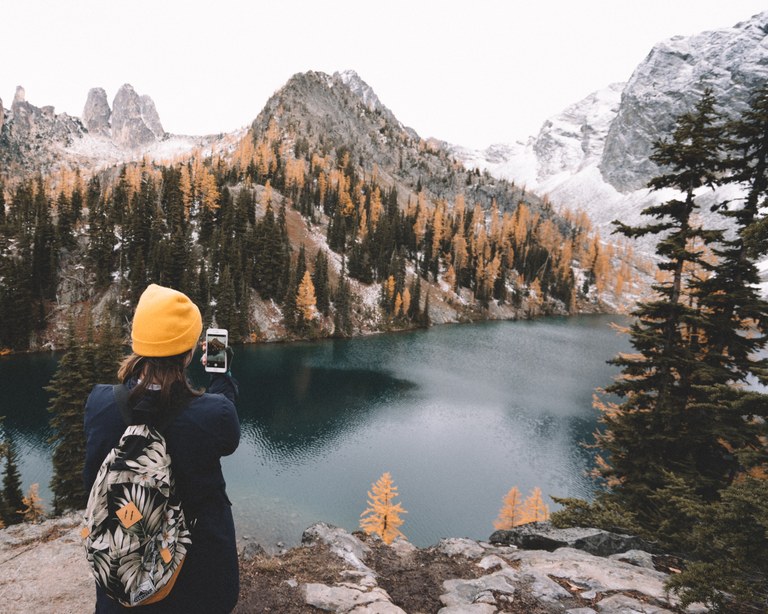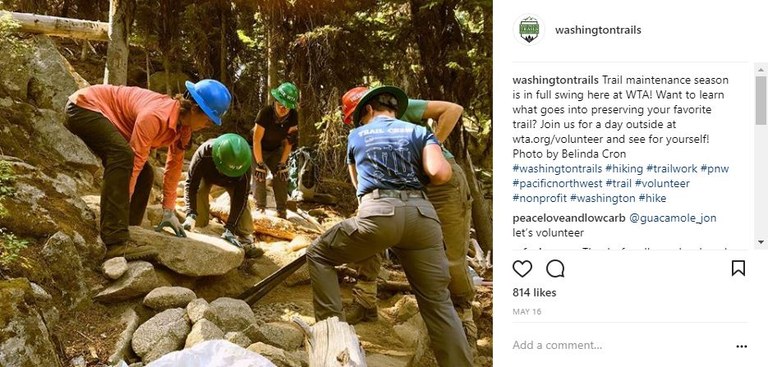Leave No Trace Releases New Social Media Guidelines
Consider these useful tips before posting your hiking photos on social media.
Social media plays a big role in many people's lives, and it's only natural that our love of sharing would extend to the outdoors. As more and more hikers are enjoying trails, it's important to remember that social media can have an impact on how good hiking behavior is shared in the hiking community.

A hiker stops to take a photo in the North Cascades. Photo by adrian.>
This week, the national Leave No Trace Center for Outdoor Ethics released a set of guidelines with tips on how to promote positive hiking behavior to ensure that the trails we all love to hike on will be kept in good condition for everyone to enjoy.
The Leave No Trace Center guidelines include:
- Tag your photos thoughtfully. Consider the implications of sharing popular trails that see a lot of use.
- Be mindful of the images you share. What story your photo is telling? Is it sharing positive behavior?
- Give back. Help the organizations and causes that can help trails and the outdoors. Consider giving back by volunteering or looking into stewardship opportunities.
- Encourage Leave No Trace ethics. Talk about and show the benefits of keeping the outdoors and trails in good condition by picking up trash and considering the Leave No Trace principles. Note: It's better to lead by example here rather than call out other hikers.
An ongoing conversation in Washington
The idea of using social media responsibly is something the outdoor and hiking community has been thinking about for a while here in Washington. Last week, WTA's communications director, Kindra Ramos, sat down with KUOW and Olympic National Park's Chief Ranger, Jay Shields, to talk about the impacts social media can have on the outdoors.
"Social media can inspire more people to get outdoors," Ramos said. "But inspiration is a first step towards meaningful stewardship."
Tips for Tagging and locations
Here at Washington Trails Association, one of our goals is to make public lands accessible to all, to help hikers connect with the 5,000+ trails on public lands across the state.
On our own social media channels, we generally try to name the trail, park or forest where a photo was taken. But we also recognize that some well-known trails, fragile places (or trails with limited capacity for parking or boot traffic) can suffer from out-sized social media attention. So, in peak hiking season, we avoid recommending or sharing photos from popular trails.
When it comes to tagging in your own posts, consider that there are potential impacts of your share.
- If you visit a fragile backcountry environment, consider the implications of leaving an exact geo-targeted location on your social media posts, as that may encourage a larger number of people to visit an area not intended for heavy use. The decision is up to you on how you decide to tag.
- If you're on a popular trail, consider showcasing how to treat and navigate well-traveled trails so other hikers can understand the implications of hiking in some of the more popular areas in Washington. For example, point out how cutting switchbacks can damage plant life, etc.
Stewarding through imagery
Setting a good example in your photos will do a lot to spread good trail behavior. Consider that the images you share could be seen by a large number of people. You can have a big impact on how the outdoors are viewed!
- Ensure that you're showing your camp in designated sites and at least 200 feet from water sources.
- Show hikers staying on the trail, and even picking up trash to help promote positive habits in the outdoors.
- No matter how cute a face they have or how much they beg, a sweet shot on your phone isn't a reason to feed or approach wildlife too closely. Use a zoom lens to capture wildlife from a safe distance. This not only keeps you safe, but doesn’t disrupt the animals in their natural habitat.
Giving back
Encouraging positive hiking behavior on social media is a great way to spread the word. When you're ready to take the next step, consider volunteering with us (or another awesome outdoor-oriented nonprofit) to give back even more. Volunteering not only helps other hikers and the trails themselves, but also will help you build a strong connection to our public lands.

Leave no trace
The Leave No Trace principles are a great guide to lessening your impact on our wild spaces and trails. Practice these both on-trail and in the images you share on social media. Encourage others to join you in caring for the outdoors!


Comments
Melodi Y on Leave No Trace Releases New Social Media Guidelines
Great article, good tips! Thank you, WTA.
Posted by:
HeyItsTurkleton on Jun 13, 2018 07:01 PM
Holly Anderson on Leave No Trace Releases New Social Media Guidelines
I'd like to add to my comments from 3 years ago and the quote that was shared via the KUOW interview... Back then I did vehemently feel that social media was having a terrible impact on trials. Back then I saw so much trash, dealt with more rude people than nice ones, and was downright disheartened to see the places I grew up hiking and loving being misused so intensely by this new wave of hikers who only seemed to be doing it for the photo.
Now, 3 years later... I feel like I hardly see trash, more folks have taken the time to learn how to be a courteous outdoors-person, and are thoughtfully using trails with a true love in their heart for the access to such pristine nature they provide. There are still the gray-jay feeders and the snubbing few, but the numbers have drastically shifted and I think it is largely in thanks to the work the WTA and groups like it do. Also, some of the more popular "grammers" seem to have taken on a wonderful mission of sharing these lessons.
My new concern is how many folks now enter some of the tougher trails with little to no preparation... no backpacks, no water, no 10 essentials. I think that Jay Shields had such a good point about the increase in number of S&R missions and how our next big step is helping people really understand what it takes to enter a space and do it safely!
Thank you so much for focusing on this issue so thoughtfully! :)
Posted by:
Holly Anderson on Jun 14, 2018 08:40 AM
Christy on Leave No Trace Releases New Social Media Guidelines
What a great article! And I'm encouraged by what Holly Anderson has to say below. Hopefully the dog poop bag-leavers have finally caught on that you don't leave bagged poop on the trail!
I do wish the LNT folks had addressed technology as well as social media--I still think there is a scourge of people that don't respect others' right to quiet (by playing music on the trail or in camp). But, this is a good start.
Posted by:
"Christy" on Jun 14, 2018 10:40 AM
Luke Bakken on Leave No Trace Releases New Social Media Guidelines
These are great suggestions and I hope this article reaches a wide audience.
I would like to add that images with dogs should always show them on-leash, because they should always *be* on-leash. Also, do you really need to risk burning a forest down by having that campfire? Probably not, especially since the majority of fires are human-caused. Finally, I can't agree enough with Christy about the annoying habit of playing music for others to hear while outdoors. Headphones exist for a reason.
Posted by:
Luke Bakken on Jun 14, 2018 11:08 AM
John Morrow on Leave No Trace Releases New Social Media Guidelines
"Social media can inspire more people to get outdoors," Ramos said. "But inspiration is a first step towards meaningful stewardship.".....Honestly, when I first started exploring the PNW in the late 1980's there were many more wilderness loving people involved in advocacy than I see today. I have yet to clearly see how giving people detailed info where to get out in our beautiful places translates to advocacy of wildlands and wilderness. Maybe it was true for Spring and Manning's generation but I think it is practically a myth today.
John
Posted by:
John Morrow on Jul 24, 2018 05:01 PM
Douglas S. Squirrel on Leave No Trace Releases New Social Media Guidelines
Has WTA ever thought about following this guidance itself by disabling trip reports on over-impacted, sensitive, and off-trail areas?
This article was recently re-posted by Washington Hikers and Climbers, which stopped allowing posts about Colchuck Lake in response to the ranger district's concerns about over-use. The move was much too little too late, but if the most desperate attention-seeking social media group in the state is willing to do at least *something*, why isn't WTA?
Trip reports play the same role as social media. People post them not to inform, but to receive validation. In that sense, this site contributes to the impact on places like Colchuck (three trip reports in a single day this weekend - what purpose does this even serve?). As people hike in greater and greater numbers, people desperate to brag about their "find" will go to more and more remote areas and create pressure on these sensitive places. WTA could help discourage this by limiting trip reports to named, numbered trails that aren't experiencing problems with illegal parking and overflowing trash cans at the trailhead (see: Lake 22).
You could also add data collection for incidences of human waste and violations of wilderness regulations (dogs in restricted areas, illegal campfires, dogs off leash, drone use) and shut down trip reports on trails where these reports rise above a certain threshold.
You could go further. Create a coalition with WHAC, NWHikers, and AllTrails to pull down hikes that are being used irresponsibly. Partner with the forest service and DNR to close trails and roads to let overused areas recover. Work with the land managers to create a reservation system for trailhead parking lots and a program of booting cars that violate parking regulations, since trail access essentially comes down to the ability to park (and towing is impractical at the scale of the current abuse).
Let's be honest about what hiking has become, and let's find ways to create real incentives for civility. Polite "guidance" is a whisper in a hurricane.
Posted by:
Douglas S. Squirrel on Jul 20, 2020 07:30 AM